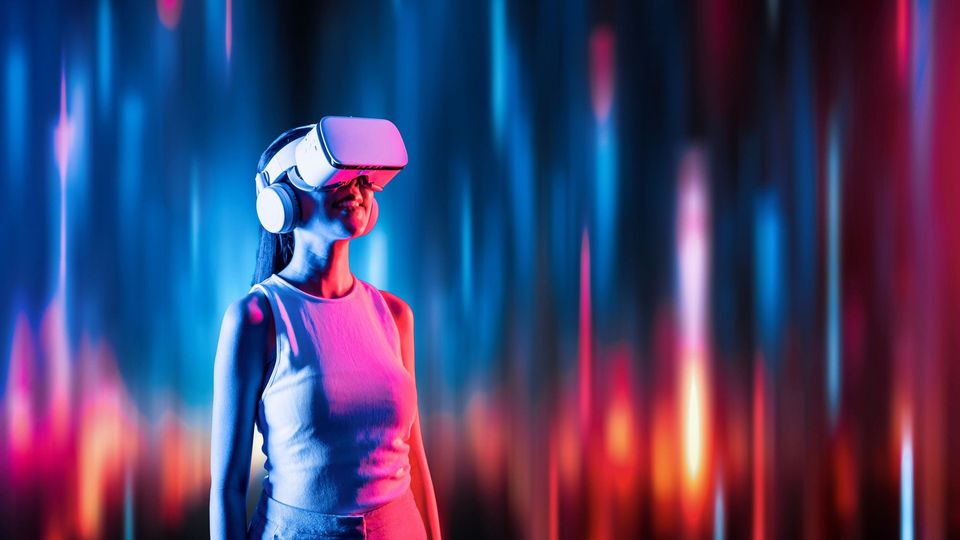AI-Driven Virtual Reality Labs Are Transforming Research
VR enables researchers to step into fully interactive spaces that mirror real-world laboratory environments.

Complete the form below to unlock access to ALL audio articles.
Virtual reality (VR), which replaces the physical world with an entirely computer-generated one, is finding use beyond gaming. VR has been gaining acceptance in the lab, where it enables researchers to step into fully interactive spaces that mirror real-world lab environments. Combined with artificial intelligence (AI)-driven virtual assistants, VR labs offer researchers a way of running experiments and attending training in a virtual environment.
Technology Networks caught up with Dr. Stephen Hilton, associate professor at University College London School of Pharmacy, to discuss how VR and AI can be introduced into the lab of the future to help improve global collaboration and provide more equitable access to advanced scientific infrastructure.
How can VR labs and AI-driven multilingual voice assistants help improve collaboration between laboratories across the globe?
By digitizing laboratory spaces and equipment and converting them into fully interactive VR environments, we allow scientists anywhere in the world to work together in real time – regardless of time zone or location. These digital twin laboratories enable 24/7 access, standardized training and direct interaction with experimental setups, to remove geographic and institutional barriers to collaboration.
AI assistants integrated into these VR spaces – such as our multilingual avatars Sam, Susan, Ingrid and the chemistry advisor Jarvis – act as real-time guides. They help navigate complex procedures, support experimental planning, ensure safety compliance and offer tailored advice in multiple languages, including English, Arabic, Hindi, Mandarin, Italian and many others. This helps to break down language barriers and ensures all researchers receive consistent, high-quality support.
Together, these technologies are built into Digital Virtual Centers that aim to unify global scientific communities and disciplines, enhance inclusivity and democratize access to advanced tools, education and collaboration opportunities.
Lab427 is our custom-built virtual reality software platform, which is designed to replicate and enhance the laboratory experience in an immersive digital environment. Accessible via standard VR headsets like the Meta Quest 2/3/3S or via PC mode, Lab427 allows users to enter a fully interactive digital laboratory where they can run experiments, attend training sessions or collaborate globally in real time.
The key advantage of Lab427 is its ability to blend the real and virtual. Scientists can log in from anywhere in the world and engage with real-time data, digital twins of equipment and intelligent AI assistants. It removes the need for physical co-location while maintaining the richness of in-person lab interaction.
For remote teamwork, this means 24/7 access to standardized training modules, seamless data sharing and the ability to co-design and run experiments across continents. In research, Lab427 helps to build faster iteration, safer testing environments and more equitable access to advanced scientific infrastructure.
Our AI avatars are trained using a combination of structured laboratory protocols, health and safety guidelines and curated expert input from scientists and educators. We use rule-based systems enriched with conversational AI models and integrated telemetry data from real lab instruments to allow the avatars to guide users through complex lab procedures.
Each avatar has a specific role:
- Sam helps with inventory management and experimental planning.
- Susan focuses on lab safety and compliance training.
- Ingrid assists with equipment use and experiment setup.
- Jarvis, our most advanced AI, pulls real-time data from global lab networks and provides multilingual, context-aware advice on reaction optimization.
These avatars can accurately execute a wide range of support tasks: guiding users through high-performance liquid chromatography (HPLC) setup, alerting users to safety breaches, helping troubleshoot experiments and even suggesting modifications based on live sensor data from connected labs. A notable example is during VR-based HPLC training, where over 200 students in one week interacted with avatars like Ingrid to learn how to set up and operate HPLC instruments. This led to a 76% reported increase in understanding and an 84% enjoyment rating. Another example is Jarvis’s ability to advise on live chemical reactions occurring in labs in different countries – offering real-time, multilingual insights without human supervision.
VR and AI fundamentally redefine accessibility by removing the traditional barriers of geography, equipment cost and infrastructure. Through affordable VR headsets combined with internet connectivity, we can bring high-quality scientific training and lab experiences to researchers and students who may have no access to physical laboratories.
In underserved regions, this means that a student without a local science lab can still learn to use HPLC equipment, understand safety protocols or even participate in international collaborative projects – all from their own home or school. For researchers, it enables real-time collaboration and access to global networks, leveling the playing field in scientific discovery and education.
We’ve already seen this impact in pilot collaborations between the UK and Thailand, where identical training and workflows were delivered seamlessly through our VR system. By integrating VR and AI, we’re building a more inclusive and connected global scientific community – where location is no longer a limitation.
How do you envision VR and AI transforming the way scientific research and training are conducted, particularly in the context of remote working and global collaboration?
We’re on the cusp of a major shift in how science is done – where VR and AI will make remote, real-time, globally connected research the norm, not the exception.
VR allows us to digitize entire laboratories, enabling researchers and trainees to step into fully interactive spaces that mirror real-world equipment and protocols. AI, particularly multilingual conversational agents, brings personalized, intelligent support into these virtual environments – offering everything from live data analysis to procedural guidance and safety checks.
In the context of remote working, this creates continuity and consistency. A chemist in Nairobi can work on a shared experiment with a colleague in London or Bangkok, using synchronized lab twins and receiving advice from the same AI assistant. Training becomes scalable, equitable and always available – with no need for physical relocation or costly infrastructure.
Global collaboration, too, is revolutionized. Through Digital Virtual Centers, scientists from different time zones and institutions can meet in VR, analyze real-time telemetry from connected labs via devices like our Proteus Aether system and receive experiment optimization tips from AI like Jarvis, who understands their local language and scientific context.
This is not science fiction – it’s happening now. And in the next few years, we believe this model will become the gold standard for sustainable, inclusive and efficient scientific research and education worldwide.





